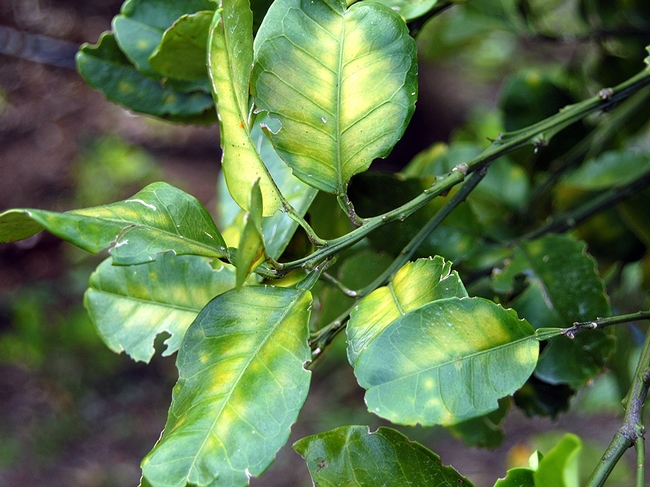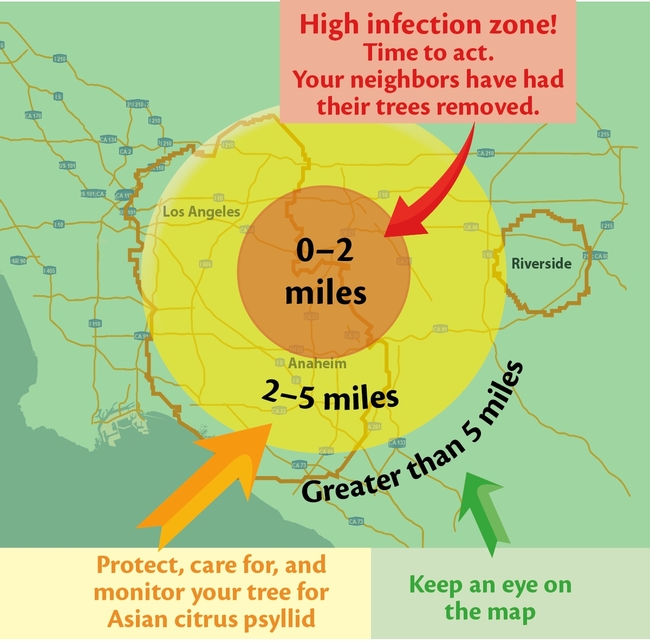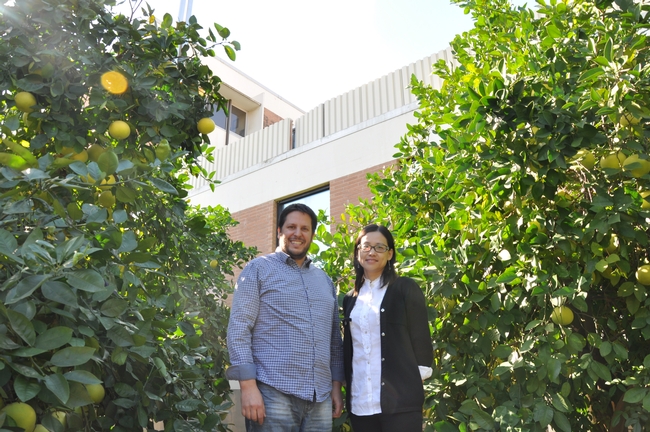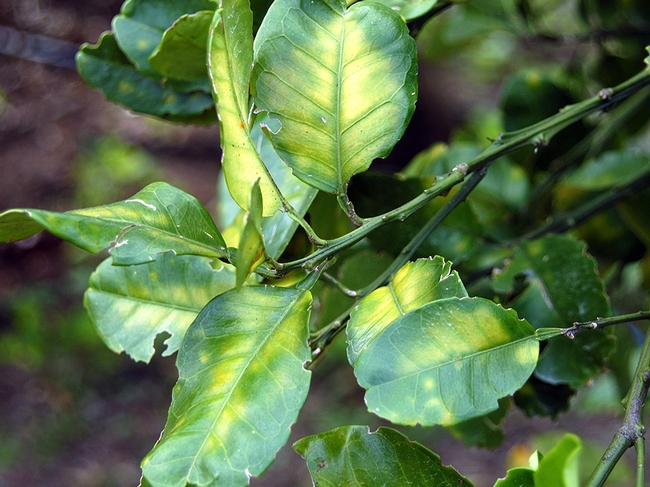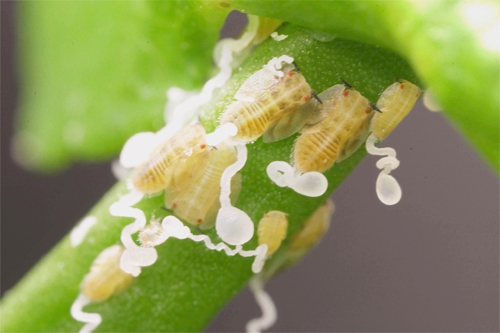Posts Tagged: Huanglongbing
UC Riverside researcher discovers first effective treatment for citrus-destroying disease
UC Riverside scientists have found the first substance capable of controlling Citrus Greening Disease, which has devastated citrus farms in Florida and also threatens California.
The new treatment effectively kills the bacterium causing the disease with a naturally occurring molecule found in wild citrus relatives. This molecule, an antimicrobial peptide, offers numerous advantages over the antibiotics currently used to treat the disease.
UCR geneticist Hailing Jin, who discovered the cure after a five-year search, explained that unlike antibiotic sprays, the peptide is stable even when used outdoors in high heat, easy to manufacture, and safe for humans.
“This peptide is found in the fruit of greening-tolerant Australian finger limes, which has been consumed for hundreds of years,” Jin said. “It is much safer to use this natural plant product on agricultural crops than other synthetic chemicals.”
Currently, some growers in Florida are spraying antibiotics and pesticides in an attempt to save trees from the CLas bacterium that causes citrus greening, also known as Huanglongbing or HLB.
“Most antibiotics are temperature sensitive, so their effects are largely reduced when applied in the hot weather,” Jin said. “By contrast, this peptide is stable even when used in 130-degree heat.”
Jin found the peptide by examining plants such as the Australian finger lime known to possess natural tolerance for the bacteria that causes Citrus Greening Disease, and she isolated the genes that contribute to this innate immunity. One of these genes produces the peptide, which she then tested over the course of two years. Improvement was soon visible.
“You can see the bacteria drastically reduced, and the leaves appear healthy again only a few months after treatment,” Jin said.
Because the peptide only needs to be reapplied a few times per year, it is highly cost effective for growers. This peptide can also be developed into a vaccine-like solution to protect young healthy plants from infection, as it is able to induce the plant's innate immunity to the bacteria.
Jin's peptide can be applied by injection or foliage spray, and it moves systemically through plants and remains stable, which makes the effect of the treatment stronger.
The treatment will be further enhanced with proprietary injection technology made by Invaio Sciences. UC Riverside has entered into an exclusive, worldwide license agreement with Invaio, ensuring this new treatment goes exactly where it's needed in plants.
“Invaio is enthusiastic to partner with UC Riverside and advance this innovative technology for combating the disease known as Citrus Greening or Huanglongbing,” said Invaio Chief Science Officer Gerardo Ramos. “The prospect of addressing this previously incurable and devastating crop disease, helping agricultural communities and improving the environmental impact of production is exciting and rewarding,” he said. “This is crop protection in harmony with nature.”
The need for an HLB cure is a global problem, but hits especially close to home as California produces 80 percent of all the fresh citrus in the United States, said Brian Suh, director of technology commercialization in UCR's Office of Technology Partnerships, which helps bring university technology to market for the benefit of society through licenses, partnerships, and startup companies.
“This license to Invaio opens up the opportunity for a product to get to market faster,” Suh said. “Cutting edge research from UCR, like the peptide identified by Dr. Jin, has a tremendous amount of commercial potential and can transform the trajectory of real-world problems with these innovative solutions.”
Consult UC ANR's map to see how close you live to citrus with HLB disease
UC Cooperative Extension developed an online interactive map that allows Californians to see how close they live to citrus trees infected with huanglongbing disease, reported Jeanette Marantos in the Los Angeles Times. This information is critical for the more than 60% of Californians who are growing their own backyard orange, grapefruit, mandarin, lime and other citrus trees.
Huanglongbing is an exotic citrus disease that kills every tree it infects. An exotic insect, the Asian citrus psyllid, spreads the disease from tree to tree. If the disease makes its way into California's commercial citrus production regions, it threatens the state's valuable and iconic citrus industry.
Go to http://ucanr.edu/hlbapp and type in your address. If you are inside the red circle — within two miles of a hot zone — UCCE suggests you remove your citrus trees and plant different types of fruit trees, such as peaches, pears, apples or figs, until researchers find a cure. In the yellow circle — within two to five miles of a hot zone — consider replacing your tree with a non-citrus fruit tree or protect your citrus trees. Find detailed information on home citrus management here https://ucanr.edu/sites/ACP/Homeowner_Options/
“When we first started this program back in 2012, I was encouraging Master Gardeners to teach homeowners how to treat their trees [to discourage psyllids, which are the insects that spread HLB],” she said, “but the complaint came back from the Master Gardeners, ‘I treat my trees but none of my neighbors do, so what's the point?'” said Beth Grafton-Cardwell, UC Cooperative Extension entomology specialist and director of the Lindcove Research and Extension Center in Exeter.
Grafton-Cardwell said the threat is serious. HLB disease devastated Florida's citrus industry when it hit in 2005, destroying half of its acreage and production, and pretty much eliminating residential citrus.
The battle against the psyllid in California is being helped by the introduction in 2011 of Tamarixia radiata, a parasitic wasp native to Pakistan, by UC Cooperative Extension biological control specialist Mark Hoddle and his entomologist wife Christina Hoddle.
"We've had psyllid here [in California] since 2008, but we still have a lot of oranges,” Hoddle said. “The disease hasn't swept through California the way it did through Florida, and I believe our biological control program is why. Psyllid populations have decreased by 70% to 80% since our first parasite release in 2011. We haven't wiped out HLB in citrus trees, but we have mitigated the risk.”
Deadly Citrus Greening Disease: A Better Lure for Asian Citrus Psyllids
If you like or grow citrus, you ought to be worried about the worldwide threat of the deadly citrus greening disease (Huanglongbing or HLB) caused by...
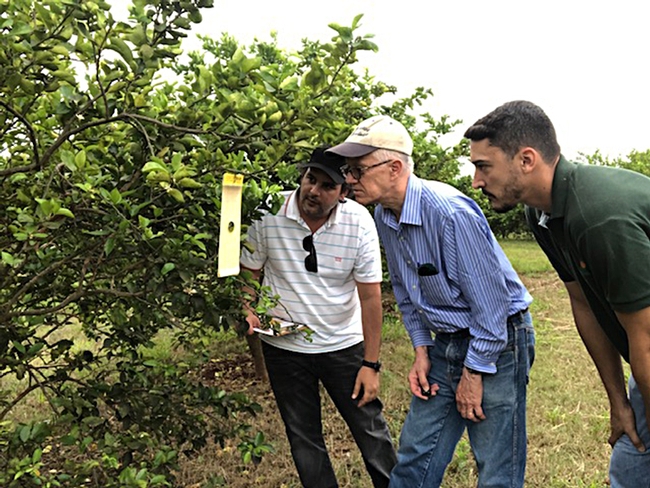
UC Davis chemical ecologist Walter Leal (center) examines a lure in Mogi Mirin, São Paulo on Brazil’s Independence Day (Sept. 7) with Haroldo Volpe (far right) and Renato de Freitas, both of Fundecitrus.
Screen installed over the 'parent navel' in Riverside to protect it from disease
City of Riverside staff draped a synthetic screen on a steel frame to encompass the 'parent navel' orange tree at the corner of Arlington and Magnolia avenues in Riverside to protect it from Asian citrus psyllids that spread huanglongbing disease, reported Ryan Hagen in the Riverside Press-Enterprise. Huanglongbing (HLB) is a devastating bacterial disease of citrus that is starting to spread rapidly in urban areas of Southern California.
The newly covered tree is valued for its status as an early ancestor of all Washington navel orange trees.
UC Cooperative Extension specialist Georgios Vidalakis, the UC Presidential Researcher for Sustainable Citrus Clonal Protection, was on site when the tree was enclosed within the new cover.
“This one will buy us a few years so the city can design a more elegant structure like you see in arboretums — maybe a wood hexagonal pavilion that will be aesthetically more pleasant,” Vidalakis said. “Unless in the next few years we find a solution.”
UC Agriculture and Natural Resources specialists and advisors are working with the citrus industry, USDA and CDFA to control ACP populations and keep HLB contained while researchers search for a cure for the disease.
Huanglongbing is a growing threat to California’s citrus industry
Asian citrus psyllid was first identified in California in 2008, and has been found from San Diego and Imperial counties in the south, all the way to Sacramento County in the north. See a map of Asian citrus psyllid and huanglongbing distribution in California.
UC Agriculture and Natural Resources specialists and advisors are working with the citrus industry, USDA and CDFA to control ACP populations and keep HLB contained while researchers search for a cure for the disease.
In order to find and remove infected trees before ACP can spread the disease to other trees, UC scientists are focusing research on early HLB detection technologies (EDTs). When infections first start, the bacteria are in just a few leaves. If the sampler doesn't collect those leaves, the disease can be missed. It can take one to two years for the bacteria to distribute itself throughout the tree so this sampling error doesn't occur.
Early detection technologies use whole tree responses to early infections. For example, Carolyn Slupsky, food science and technology professor at UC Davis, measures changes in tree metabolism (its day-to-day chemical function) when it becomes infected. Every leaf on the tree is connected to the tree's metabolism, so it doesn't matter which leaf is collected. This type of test can detect an infected tree within weeks or months after infection instead of years.
Scientists are also studying ways to modify ACP so the insects are unable to spread HLB, and studying the use of conventional breeding, genome editing or genetic engineering to develop disease-resistant citrus. Read summaries of the research here.
Keeping Asian citrus psyllid and huanglongbing disease at bay depends in large part on the active involvement of commercial citrus growers and California residents who have citrus trees in their home landscapes. The UC ANR Asian Citrus Psyllid Distribution and Management website provides detailed guidelines for growers and residents to monitor for Asian citrus psyllid and huanglongbing, and learn about options for reducing psyllid populations and responding to the disease if it's in your area.
View a four-minute video that shows how to monitor for ACP presence in residential citrus:


